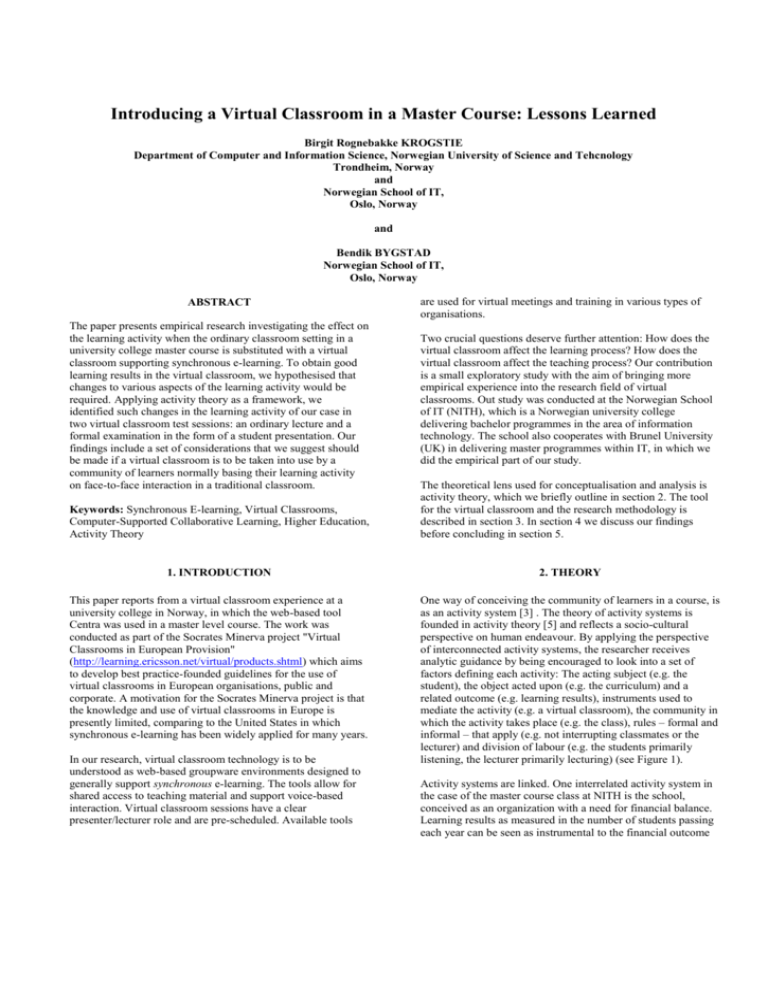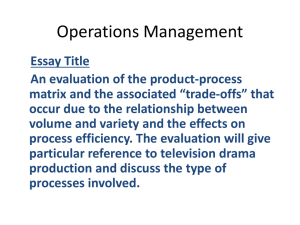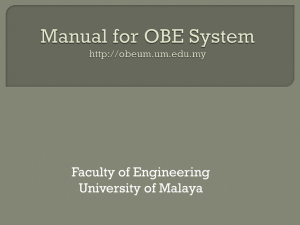Using Virtual Classroom Systems in a Masters Course: Lessons
advertisement

Introducing a Virtual Classroom in a Master Course: Lessons Learned Birgit Rognebakke KROGSTIE Department of Computer and Information Science, Norwegian University of Science and Tehcnology Trondheim, Norway and Norwegian School of IT, Oslo, Norway and Bendik BYGSTAD Norwegian School of IT, Oslo, Norway ABSTRACT The paper presents empirical research investigating the effect on the learning activity when the ordinary classroom setting in a university college master course is substituted with a virtual classroom supporting synchronous e-learning. To obtain good learning results in the virtual classroom, we hypothesised that changes to various aspects of the learning activity would be required. Applying activity theory as a framework, we identified such changes in the learning activity of our case in two virtual classroom test sessions: an ordinary lecture and a formal examination in the form of a student presentation. Our findings include a set of considerations that we suggest should be made if a virtual classroom is to be taken into use by a community of learners normally basing their learning activity on face-to-face interaction in a traditional classroom. Keywords: Synchronous E-learning, Virtual Classrooms, Computer-Supported Collaborative Learning, Higher Education, Activity Theory are used for virtual meetings and training in various types of organisations. Two crucial questions deserve further attention: How does the virtual classroom affect the learning process? How does the virtual classroom affect the teaching process? Our contribution is a small exploratory study with the aim of bringing more empirical experience into the research field of virtual classrooms. Out study was conducted at the Norwegian School of IT (NITH), which is a Norwegian university college delivering bachelor programmes in the area of information technology. The school also cooperates with Brunel University (UK) in delivering master programmes within IT, in which we did the empirical part of our study. The theoretical lens used for conceptualisation and analysis is activity theory, which we briefly outline in section 2. The tool for the virtual classroom and the research methodology is described in section 3. In section 4 we discuss our findings before concluding in section 5. 1. INTRODUCTION 2. THEORY This paper reports from a virtual classroom experience at a university college in Norway, in which the web-based tool Centra was used in a master level course. The work was conducted as part of the Socrates Minerva project "Virtual Classrooms in European Provision" (http://learning.ericsson.net/virtual/products.shtml) which aims to develop best practice-founded guidelines for the use of virtual classrooms in European organisations, public and corporate. A motivation for the Socrates Minerva project is that the knowledge and use of virtual classrooms in Europe is presently limited, comparing to the United States in which synchronous e-learning has been widely applied for many years. One way of conceiving the community of learners in a course, is as an activity system [3] . The theory of activity systems is founded in activity theory [5] and reflects a socio-cultural perspective on human endeavour. By applying the perspective of interconnected activity systems, the researcher receives analytic guidance by being encouraged to look into a set of factors defining each activity: The acting subject (e.g. the student), the object acted upon (e.g. the curriculum) and a related outcome (e.g. learning results), instruments used to mediate the activity (e.g. a virtual classroom), the community in which the activity takes place (e.g. the class), rules – formal and informal – that apply (e.g. not interrupting classmates or the lecturer) and division of labour (e.g. the students primarily listening, the lecturer primarily lecturing) (see Figure 1). In our research, virtual classroom technology is to be understood as web-based groupware environments designed to generally support synchronous e-learning. The tools allow for shared access to teaching material and support voice-based interaction. Virtual classroom sessions have a clear presenter/lecturer role and are pre-scheduled. Available tools Activity systems are linked. One interrelated activity system in the case of the master course class at NITH is the school, conceived as an organization with a need for financial balance. Learning results as measured in the number of students passing each year can be seen as instrumental to the financial outcome of the school. Other aspects of course delivery having financial implications for the school are the costs of course delivery related e.g. to information infrastructure and lecturers’ time (e.g. for travelling between campuses). To account not only for structure and the state-of-affairs but also for development of the activity system(s), focus is placed on tensions that reside within and between activities and which trigger processes of development. Engeström denote these tensions as contradictions. If changes are made in an activity system, e.g. to one node, tensions are likely to occur and changes are likely to happen in other nodes as the system develops to cope with the contradictions. The theory of activity systems is thus helpful in explaining why activity systems develop as they do, to predict how activity systems are likely to develop in response to certain change, and – to some extent – how change in a certain direction might be prevented or encouraged. In the case of the community of master course learners, any change which results in better learning outcomes on part of the students, are desirable. Changes which do not worsen learning outcomes and which simultaneously offer other advantages (such as cost savings in the interrelated activity system of the school), are also desirable. Instrument Virtual classroom Subject Student Rules Do not interrupt, Lecture attendance is voluntary, … Outcome Object Learning Curriculum results Community 1st year master course Division of labour Student listeningLecturer lecturing Figure 1: An activity system 3. THE CASE AND RESEARCH APPROACH The participation of the students in the learning activity is influenced by their backgrounds and the rules that apply, formally and informally, to the activity. The topic of the master programme course module of which the virtual classroom test sessions were part is organisational change and business improvement. The topic itself relates to the introduction of information technology, which means the students have a conscious attitude towards the use of (new) technology, e.g. as represented by the virtual classroom. The students hold bachelor degrees in information technology and are thus highly competent users of information technology. The course is workshop-based, and assessment is based on a sum of credits earned from general attendance in class and (mostly) from group and individual assignments which are to be presented orally as part of the examination. The stress on active workshop participation is likely to be significant for the students’ attitude towards their learning activity and the informal rules that apply to interaction. For instance, in a classroom session in which the lecturer or another student is the one primarily presenting, the student is expected to be relatively passive during the presentation but contribute with questions and comments during the session afterwards. The students in the class were familiar with each other at the time of our experiment, having met face-to-face in learning settings on several occasions. This means that the class could reasonably be viewed as an already established learning community or activity system. The lecturer is another important participant in the learning activity. In the case investigated, it was the first time the lecturer – who is also the co-author of this paper - taught the particular course. He was however familiar with the curriculum, and he is acknowledged by his students and colleagues as a competent lecturer. He was somewhat sceptical about the use of the virtual classroom, regarding the possibilities for technical failure as high. In terms of functionality, virtual classrooms from various vendors are fairly similar, which makes it reasonable to draw conclusions about virtual classrooms in general based on the use of one of them. Without further elaboration on the differences, we will briefly describe the functionality of Centra, the virtual classroom application used in our research: The tool offers an environment for synchronous presentation and interaction over the internet. It is typically used for online meetings and e-learning. There is audio (voice) transmission but no video transmission integrated in the environment. There is a clear distinction between the roles and rights of presenter(s) and participants. The presenter may delegate presenter rights to other participants. There is a window for presentation. Typically, what is presented is a set of slides (powerpoint) which are preloaded onto the virtual classroom server. It is also possible for the presenter to share other applications run locally on his PC, including internet browsers. In addition, there is a tool for making online drawings and comments. There is a toolbar, different for presenter and participants. The presenter may change various settings in the environment. The participants’ options are restricted to entering or leaving, raising their hand to have the floor (get the microphone), and responding to happenings in the session by selecting icons (smiley face or clapping hands, green tick (yes), red cross (no)) There is a list of participant names with information about participants’ presence and status in the interaction (hand in the air, negative or affirmative answer to the presenter’s question, comment in the form of laughter or applause, possession of the microphone), visible to all participants. The presenter is in charge of the microphone, delegating the right to speak. It is possible to allow several participants to speak simultaneously, or to restrict voice transmission to one person at the time. The presenter may launch surveys to have the participants’ response to a question or check their knowledge. The survey questions may be of different categories: yes/no, multiple choice or open ended. A visual representation (coloured bars) is generated, showing the distribution of answers. The results may be displayed to the participants. Finally, there is an opportunity for text chat. It is possible to send private messages and public ones through the chatting window. Our primary aim was to identify, on a short-term basis, changes of the learning activity that follow from the change of instructional/interactional medium. A related question is: which changes to the activity are necessary to make sure that the learning outcomes do not suffer from the transition from ordinary classroom to virtual classroom. Underlying these questions is the assumption that contradictions within and between activity systems cause change [3]. The particular class of the case was chosen because it represents a community of learners likely to benefit from flexibility in terms of students’ geographical location. The class regularly meets for several days’ workshops in Oslo. Some participants work part time besides being students, and some live in other parts of Norway and sometimes choose to attend the workshop lectures through video conferencing from the school’s other campuses. Experience with the same class in a normal classroom setting in other parts of the course provided a basis for comparison with the class in the virtual classroom setting. The lecturer was situated in another room in the same building as the PC lab, which simulated the distance to the lecturer in a virtual classroom in normal use. Also, the examinee student of our second test session (to be elaborated below) was in another geographical location, which was realistic in terms of the virtual classroom: it was a real formal examination. It was decided to collect experience from two very different pedagogical settings: one normal lecture with the lecturer presenting and the class primarily listening (Session 1), and one formal examination of a student presenting her assignment (Session 2); see Figure 2. Presenting student Centra server Sweden or Denmark Internet Stavanger, Norway Participants Teacher LAN Teacher’s office PC lab NITH campus Oslo, Norway Figure 2: Topology of the examination setting 4. FINDINGS AND DISCUSSION Data were collected through a combination of passive observation, plenary interview/discussion with the class after the sessions, a questionnaire and interviews with the lecturer and the examinee. The final grades in the course in question were not used as part of the evaluation, as the test sessions comprise just a small part of the totality of the course. We choose to co-locate the majority of the class in a PC lab during the sessions. The purpose of this was partly to reduce the chance of having unmanageable technical problems: we were trying out new technology in a real course, and requirements were strong not to cause delays in the teaching schedule or major inconvenience to the participating students. The setting made it possible for the observing researcher to convey information to participants and provide assistance e.g. on technical issues in the lab. Another effect of the setting was a resemblance to the ordinary classroom in that the students were able to communicate verbally and visually through the room and have an experience of being co-located as usual with mutual awareness of classmates’ presence and availability. On the other hand, the use of headset with microphone served to shield students from each other, partly simulating the learning setting of the virtual classroom which normally would be one with students geographically distributed. In what follows, we use the structure of the activity system as a frame of reference when presenting our empirical findings and discussing them briefly. The guiding questions are: What were the changes in the instrument of the learning activity as the classroom was changed from ordinary to virtual? Were there indications that the change was detrimental to the learning outcomes of the activity? Which changes occurred in other parts of the activity system, and can they be explained as intra-activity contradictions resulting from the transition to a virtual classroom? From the answers to the last question, it is possible to tentatively suggest which changes of the learning activity are likely to be required (and should be supported) in a similar case to maintain the learning outcome at the level of the ordinary classroom. The change made to the learning activity is a change of medium of instruction. The virtual classroom shares many characteristics with the traditional classroom lecture setting [2]. The lecture can be seen as the instructional model on which the virtual classroom is based: The slide set forms the core of the presentation, and the presenter has the leading role in the interaction. Along the constructivist – positivist scale of pedagogy, the virtual classroom is thus found at the positivist end [1] along with other presentation technology and computerised tutorials. The lecturer in our case normally, in the ordinary classroom, makes use of the blackboard or whiteboard as a supplement to the slide set presentation. The whiteboard of the virtual classroom was however not used in our case because the lecturer wanted to avoid the simultaneous introduction and use of too much functionality. The students’ reactions revealed that they perceived the channels of communication in the virtual classroom as much more limited than in the ordinary classroom and that they would have liked to use the possibility to chat – an activity which bears some resemblance to informal side comments and passing of notes in the ordinary classroom. It is mainly a pedagogical issue how the functionality offered in a virtual classroom environment should be utilised in support of instructional techniques and learning objectives. The transition to a virtual classroom was also, more generally, a change of medium of interaction, both formal and informal, among students and between students and lecturer. Looking at the virtual classroom as a shared workspace, an obvious difference from the ordinary classroom is the lack of perceptual information about other participants. Workspace awareness is generally much harder to maintain in groupware workspaces than in face-to-face environments [4 ], and awareness in the virtual classroom is limited even if some information about participants is conveyed through their voices and the participant list presented on the screen. The structured sharing of the microphone and the associated screen icon largely conveys only intentional communication. The lecturer commented strongly on the problems of limited feedback. He felt the possibility to ‘sense’ the atmosphere was missing: “To cut it short: the spatial experience of feedback is absent. Usually you get very much feedback during a [normal classroom] session with the class – body language, glances and the like. When you have finished the presentation, you have a pretty good impression of whether it was understood, liked, if you touched their hearts or if they remained stone cold…”. The lack of two-way interaction can be seen as forming a contradiction between the instrument and a set of implicit activity rules of communication within the activity. To resolve this tension, which became apparent in the pre-testing of the first session in our case, the lecturer strived to consciously integrate elements of two-way interaction into the lecture, e.g. through online surveys. An implication for similar cases is that the lecturer’s preparation of the course material must be slightly changed as compared to the normal classroom situation: As a starting point, we found that it is adequate to make use of a slide set originally meant for an ordinary classroom lecture. For the virtual classroom, elements of interactivity should be added [2]. Similarly, we identified a need to add graphical elements to achieve visual variation necessary to hold the students’ attention. The lecturer commented that the attention span of the students (and himself) seemed more limited in the virtual classroom than he experienced in the normal classroom setting After the two virtual classroom sessions, the students commented that even more surveys and graphical elements would have improved the learning experience. There were technical problems in the virtual classroom sessions, mainly relating to poor quality of audio transfer (causing occasional episodes of silence) and more general bandwidth limitations. These issues became more prevalent as the net load increased during certain times of the day. The problems were partly inherent to the tool (i.e. an intra-node contradiction) and partly related to the lecturer’s competence (contradiction between instrument and subject), which was restricted to the basic functionality and based on limited experience. One implication is that the lecturer should be equipped with skills sufficient to be able both to utilise the tool’s possibilities and to work around its limitations. For instance, the possibility to efficiently make sketches, planned or spontaneously, in the online drawing tool, would add to the variation and amount of graphical elements. Apart having from proficiency with the tool and generally in delivering training live and online, Driscoll [2] suggests that the best lecturer in live, online training is one that also is willing to try new technology is comfortable with his training skills has variety in voice and intonation is comfortable with the lack of face-to-face interaction The importance of these factors was reflected in the interview with the lecturer in our case. On the issue of voice and intonation, we note that the lecturer in the case generally has a ‘good voice’ in the ordinary classroom. After the virtual classroom sessions, the students however commented that the lecturer’s voice sounded more ‘flat’ there. The other subjects of the activity, the students, need to know how to use the virtual classroom, both in terms of rules of interaction and tool functionality. We found that when technical testing is made by staff in advance to ensure that the session runs as smoothly as possible from a technical point of view, it is possible to include the class’ tool training in the beginning of their very first tool session. The threshold to learn the necessary basics for participants turned out to be low, the tension between present and new set of skills (within the subject node of the activity) being small. A possibly useful change effort in terms of participants’ background when the virtual classroom is to be introduced would be to promote a positive attitude towards the tool, stress its possibilities and form realistic expectations. The power of motivation and skill in combination was evident in the examinee student, who had a strong motivation to take her exam from her home and was not very concerned about the technical problems. She contended afterwards: “I am used to working from home and to attend virtual meetings at work. It usually takes time to get everybody up and going with virtual meeting room environments.” The object of the learning activity as defined by the learning objectives and curriculum was the same in the virtual classroom as in the ordinary one. Both lecturer and students thought that the learning objectives of the sessions had been met and that technical problems had not been devastating from an instructional/learning point of view. The students did however generally think that learning would have been better in an ordinary classroom. In other words, they perceived a contradiction between the instrument and the learning outcome. The students’ reactions on this point suggest that a resolution of issues of variation and interaction within the virtual classroom may not be sufficient to resolve this rather fundamental contradiction. To some extent, learning results related to the test sessions could be measured: According to the lecturer, the knowledge level of these students on the topics of the test sessions as demonstrated in their subsequent assignment work, was good. The outcome of the examination performed in the virtual classroom in the second session, was excellent. The rules of interaction in the ordinary classroom do not fully suit the virtual classroom, and this tension leads to changes in the rules of interaction in the learning activity. The one-at-thetime regime normally imposed by the presenter through the tool is stricter than is normally the case in the ordinary classroom. Students in our sessions still believed that they had the necessary opportunities to participate when they wanted and that they had been participating actively in the sessions. They actively used the functionality to give response to the speaker (yes/no, laugh, applause, raised hand). The findings suggest that no special efforts are needed to make participants comply with the new rules of participation, perhaps because the rules seem inevitable: For instance, with only a voice and no supplementary visual cues about the speaker to relate to, it is necessary to let him speak alone and without interruption. Turning to the formal (rules of ) student assessment in the course used in our test sessions, they are partly based on student participation. There are formal criteria that the lecturer should look for, and one among these was no longer applicable in the virtual classroom: that of making eye contact with the audience during presentation. The transition to a virtual classroom thus makes it necessary to check the relevance of, and possible revise, the assessment criteria used in the ordinary classroom setting. Looking at the division of labour, the lecturer’s responsibility to ensure two-way interaction and generally facilitate the interaction is very clear in the virtual classroom. The management of interaction is reflected in visual cues in the virtual classroom interface as exemplified by the microphone icon associated with participant names. The tool imposes a regime of turn taking and session management that must be accepted by participants – which, as previously argued, happened without friction in our limited test sessions. How did the introduction of the virtual classroom affect the learning outcomes? In our case, the limited proportion of the course delivered through the virtual classroom makes it difficult to draw conclusions on this point. Based on students’ evaluation of the sessions we hypothesise that if a class is to use the virtual classroom regularly and not only as part of a research experiment, technical issues would have to be better resolved. We believe that patience with technical problems would have been smaller if students felt they depended on the virtual classroom for the instruction / interaction of the course. The slight fall in positive attitude (as measured in the questionnaires) from the first session to the second one supports this, as does the general opinion in class that the virtual classroom could serve as a good supplement to the ordinary classroom but not a substitute. Tentatively, we suggest that this finding is relevant at least for cases in which the learning activity is already established with an ordinary classroom as the primary instructional and interactional setting, As a supplement to the curriculum-based lectures of the course, our students envisaged that the virtual classroom be used as a medium for workshops focusing on particular topics, preferably scheduled after working hours and facilitated e.g. by the lecturer. Research on the use of real-time voice groupware technology to support students in a similar manner indicates that such sessions would have to be carefully prepared and tailored to a time limit [6], which implies a significant associated cost. Improvisation in the virtual classroom with multiple participants geographically dispersed is unlikely to be successful. The success with the formal examination in our case suggests that under certain conditions, formal examinations in the form of students' presentations can be arranged in the virtual classroom. 5. CONCLUSION This paper presented an exploratory study from Norway on how the use of a virtual classroom affects learning and teaching. A student Master class was for two sessions exposed to the use of the Centra, being observed during the sessions and interviewed afterwards. We used activity theory to frame our study. This enabled us to identify the changes in the activity system, and to analyse the effects on learning and teaching. The main finding is that the same learning outcomes as in the ordinary classroom may be achieved for students using virtual classroom technology under certain conditions. When considering the introduction of a virtual classroom as a full or partial substitute for an ordinary classroom, our findings suggest that the following major issues should be taken into account: Lecturer and students must accept that virtual learning sessions generally are more structured and predictable than learning sessions in the ordinary classroom Students who already base their learning activity mainly on face-to-face interaction are likely to see the virtual classroom as an inferior substitute for ‘the real thing’. This means that there is a challenge in convincing the students of the advantages of the virtual classroom relative to their learning needs. For communities of learners that are established with the virtual classroom as a primary medium of interaction from the start, conditions may be different. The study also documents that using a virtual classroom greatly affects teaching, particularly due to the loss of face-to-face contact with students. Given the present functionality of virtual classroom tools, the lecturer will have to live with these constraints on interaction. 6. REFERENCES [1] [2] [3] [4] [5] [6] Benbunan-Fich, R., “Improving Education and Training With IT”, Communications of the ACM Vol.45, Issue 6, 2002 J-A.Driscoll, “Designing and Delivering Live, Online Training, COLUMN: E-learning basics: essay”, eLearn Vol.2001 Issue 10, 2001. Y.Engeström, Learning by expanding. An activitytheoretical approach to developmental research. Helsinki: Orienta-konsultit Oy, 1987. C.G. Gutwin and C.G, Saul: “A descriptive Framework of Worskpace Awareness for Real-Time Groupware”, Computer Supported Cooperative Work (CSCW), Journal of Collaborative Computing 2001 A.N. Leont’ev: Problems of the development of the mind, Moscow: Progress Publishers, 1981 Rapanotti, L.; Blake, C.T. and Griffiths, R.: “eTutorials with Voice Groupware: real-time conferencing to support computing students at a distance”, ITiCSE’02, June 24-26, Aarhus, Denmark, 2002.





